

Enhanced protection for 'fragile' gulf neighbouring world-famous Ningaloo Reef — but developers remain determined. Environmentalists are hoping the West Australian government's new safeguards for the Exmouth Gulf will signal an end to "industrial threats", but developers say they will be not deterred.
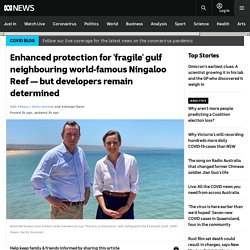
Key points: A new marine park will be established in the Exmouth GulfThe EPA has recommended "enhanced" protection for the gulfDevelopers say the new protections won't affect their plans Premier Mark McGowan and Environment Minister Amber-Jade Sanderson visited the popular tourist destination of Exmouth on Friday to announce a new marine park as well as new Class A reserves. The announcements come in response to an Environmental Protection Authority (EPA) report which found protection of the Exmouth Gulf needed to be "enhanced". The Exmouth Gulf neighbours the world-famous Ningaloo Reef, 1,250km north of Perth, and is recognised as a significant location for both locals and visitors.
'Genetic rescue' mission to save endangered eastern bristlebird from extinction. The eastern bristlebird is a small, stealthy, ground-dwelling bird that lives in dense undergrowth and is very good at camouflaging.
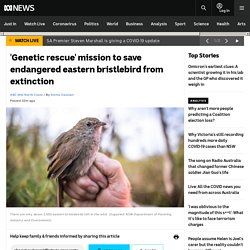
But that's not why they're becoming increasingly harder to spot. Key points: A technique known as genetic rescue is being used to save endangered eastern bristlebirds from extinctionThere are only about 2,500 eastern bristlebirds left in the wildTheir populations are separated which can result in low genetic diversity and reduce overall fitness and survival Only about 2,500 eastern bristlebirds are left in the wild, spread across isolated populations in eastern NSW and southern Queensland. New research shows one third of Australia's threatened birds have become endangered over past decade. At sunset on Darwin's Lee Point Beach, thousands of shorebirds crowd together at the high tide line, and swirl up into a coordinated dance across the sky when disturbed.
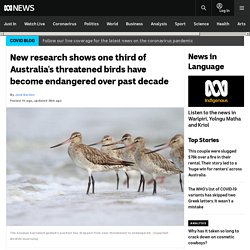
A third of Australia's most threatened species have declined furtherMigratory shorebirds are losing feeding habitats all along their migration routesClimate change is reducing numbers of tropical species, scientists say "There's often 10, 15, species in a flock like this," Charles Darwin University Professor of Conservation Stephen Garnett said. "We can see red-necked stint, ruddy turnstone, greater and lesser sand plover, great knots, red knots, sanderling, there's whimbrel and godwit. " But he said the large numbers of migratory birds, which roost here at this time of year, belie big drops in their populations globally. Shorebirds including the curlew sandpiper, ruddy turnstone, sharp-tailed sandpiper and common greenshank and grey plover are among birds that have sharply declined.
VicForests accused of returning logged public forests as weed-infested fields. Sydney architect Ian Moore likes the feel of timber from Victoria's ash forests.
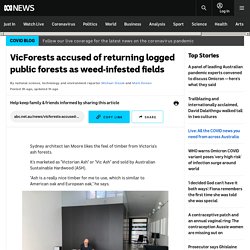
It's marketed as "Victorian Ash" or "Vic Ash" and sold by Australian Sustainable Hardwood (ASH). "Ash is a really nice timber for me to use, which is similar to American oak and European oak," he says. The blonde colour, according to Mr Moore, means it brings the warmth of wood without the orange or red hues that come with some other hardwoods. Central to Ian Moore's work is sustainability and Victorian ash is pitched as "the most environmentally friendly building product available". "When I first looked at it, you know, you read the material about sustainable logging… I would have said that it was a very good choice from a sustainable point of view," says Mr Moore.
Greens call for ban on filling in wombats' burrows as Murraylands incident investigated. Landowners who fill in burrows and "bury wombats alive" would face potential jail time, under a proposal from the South Australian Greens.
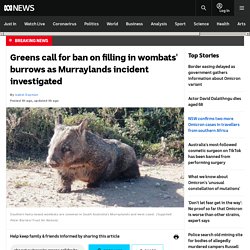
Key points: The leader of the Greens has raised concerns about wombats being buried aliveShe has introduced a bill to specifically ban filling in their burrowsThe Department for Environment and Water is investigating the incident. Wild bilbies found in Currawinya National Park for first time in 70 years. It was a night Kevin Bradley says he will "never, ever forget".
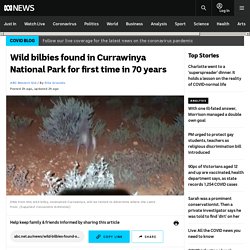
On an evening in May, Kevin Bradley was conducting a routine check on the bilbies that live inside a fenced-off part of Currawinya National Park, in south-west Queensland, when he saw movement in the distance. It was something that, in more than 20 years of bilby conservation work, he had never seen. "I saw this little animal skipping along the side of the road," Mr Bradley said. "I couldn't believe my eyes. It was a bilby. Another Port River dolphin found dead as interim report struggles to identify a cause. A third dolphin has been found dead inside the Adelaide Dolphin Sanctuary, but despite showing similar symptoms to other dead or missing mammals an interim investigation is no closer to finding the cause.
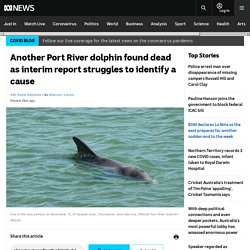
Key points: There have been three dolphins found dead in the Port River and a fourth at nearby SemaphoreTwo other Port River dolphins remain missing after showing similar symptoms of illnessInvestigators broaden their scope after failing to find a definitive cause of death or common links A four-year-old dolphin known by enthusiasts variously as Squeak or Mimo was found dead late on Sunday near Fletcher's Slip on the Port River. Squeak was the latest Port River dolphin to be showing signs of emaciation and illness after his older brother, Hunter, had to be euthanised due to severe ill health. Southern right whale satellite tagging project blows migration assumptions out of water. It has long been thought that the majestic and peaceful southern right whale headed south to Antarctica after frequenting Australia's coast and the Auckland Islands south of New Zealand each winter.
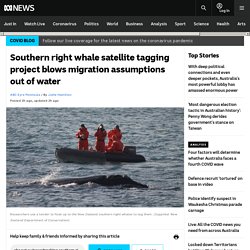
New Zealand southern right whales once numbered about 30,000 but whaling saw them drop to just 40 in the 1920sA satellite tracking program followed the whales' migration west to below Australia, breaking myths they head south or east from traditional breeding groundsThe international research program is assessing the impact of climate change on the whales But is that where they really go? Until now, the whales' movements away from the breeding grounds have largely been a guessing game. Hidden in plain sight, the endangered button wrinklewort makes a revival. As trains rattle past, daisies are pushing up through the soil on three vacant blocks next to the Sunbury line.
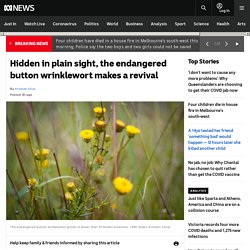
But far from a euphemism about death, these particular daisies embody a rare survival story. So precious are the small plants, the state government does not want their location revealed and they are secured behind 2-metre high fences. The brilliantly named button wrinklewort, an endangered wildflower, exists in fewer than 30 known locations across Victoria, NSW and the ACT. By chance, one of those spots is on a state-owned land reserve in Melbourne's north-west, surrounded by train tracks, roads, a school and suburban homes.
Spanish mackerel stock report 'imminent' as stakeholders fear for fishery's future. Australia's east coast Spanish mackerel fishery has been grossly mismanaged and urgent measures are needed to allow stocks to recover, an experienced fisheries expert has warned.
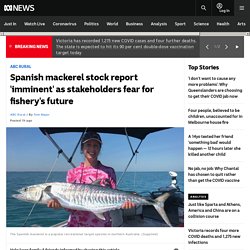
Key points: The east coast Spanish mackerel fishery could be at risk of collapse, experts sayA working group formed to examine management options hasn't met since AprilQueensland Fisheries Minister promises the release of a stock assessment report is "imminent" A preliminary stock assessment released in April estimated the east coast population of the species could be as little as 17 per cent of virgin stocks, well below the sustainable level of 60 per cent. A Fisheries Queensland spokesman confirmed a peer review has since been completed into the stock assessment but no specific date for its release has been set.
East coast Spanish mackerel schools are line-fished from south of the Torres Strait to northern New South Wales with most caught commercially north of Townsville. Predator-free sanctuary helps native wildlife thrive in Victoria's 'magical' Otways. Koalas feed among the tall trees and emus forage on the forest floor of a wildlife sanctuary in south-west Victoria conservationists hope will provide a greater insight into what the Otway Ranges were like before colonisation. Key points: The sanctuary near Apollo Bay opened in March after more than two years of work on the former farming propertyA high predator-proof fence protects native marsupials, such as potoroos, from foxes and catsResearchers are learning more about the Otways' native plant life and hope to help re-establish certain species A fence, designed to be hidden, keeps feral predators such as cats and foxes out, and allows the bandicoots and potoroos within to thrive – just as they did more than two centuries ago.
Calls to better protect wild sandalwood amid fears of extinction. As a young man, Badimia elder Ashley Bell made money from harvesting sandalwood, but now he's so concerned about the sustainability of wild sandalwood he's calling for a ban on removing it from his traditional lands. Key points: Sandalwood has been shipped out of Western Australia since 1844There are calls for greater conservation of wild sandalwood treesThe plantation industry says it is ready to fill the sandalwood market with its trees Native Australian sandalwood, Santalum spicatum, is a small, slow-growing hemiparasitic tree containing valuable heartwood which grows in the southern half of Western Australia. Wanted by incense and oil markets, sandalwood has been commercially harvested in the state for 175 years, but concerns have been raised about the sustainability of wildwood populations under current government management arrangements. Years ago, like many people, Mr Bell and his father made an income harvesting and selling sandalwood.
Gabon is the last bastion of endangered African forest elephants. Loss of habitat and poaching have made African forest elephants a critically endangered species, yet the dense forests of Gabon remain a "last stronghold" for the magnificent creatures. Key points: Evidence from a new study finds there are around 95,000 African forest elephants in Gabon, almost double the 50,000-60,000 previously estimatedResearchers used DNA testing of "steaming fresh" dung to make the estimateThe survey was Gabon's first elephant census in 30 years New research has concluded the population of elephants in the sparsely populated nation, in the Congo River Basin, is much higher than previous estimates.
Fishing changes needed with low stocks of dhufish, pink snapper report finds. The latest review of fish stocks off the WA coast between Kalbarri and Augusta has found fishery management changes and catch reductions are needed to protect popular fish such as pink snapper and dhufish. Key points: A new study has found prized WA fish such as snapper and dhufish are under threat The commercial industry says management changes are urgently needed But the recreational sector says reducing the catch is a shared responsibility It's the third major stock assessment conducted in the fishery since 2010, following a raft of cuts to fishing limits that were implemented to rebuild scalefish numbers. Queensland bat rescuers make tiny homes for microbats in last-ditch bid to save species
It's feeding time and a small group of volunteers is chopping up fresh fruit and mixing a special juice with added salt for a little bunch of fussy eaters. This rescue group on Queensland's Capricorn Coast usually cares for megabats — or fruit bats — but now their energy is focused on saving their much, much smaller cousins: microbats. These tiny bats usually live in caves but mining operations and land clearing has destroyed much of their natural habitat, so Bat Care Capricornia has engaged the help of a local Men's Shed group to build super-small homes for the vulnerable species. "There has been a lot of deforestation around here," explained Bat Care Capricornia's Pam Purton.
Retirement village development near endangered bird habitat back on table. King parrots are dying of a wasting disease that may be spreading through birdbaths. A last-ditch attempt to find the Eungella gastric-brooding frog in the wild fails — but could they be cloned from extinction? Rare palm cockatoo listed as endangered due to habitat loss, bushfires in far north Queensland. Flamingos go on show after painstaking preservation work by SA Museum taxidermists. Yarra Ranges forest the size of 94 MCGs donated to conservation. There's been a huge spike in injured and unwell turtles in south-east Queensland — but it's hard to work out why. Calls grow to spare historic 'Blewitt's Block' from development in Canberra's Molonglo Valley. New breeding pairs discovered among embattled Granite Island penguin population.
Art, science and philanthropy combine to create homes for penguins on the River Derwent and Kangaroo Island. Scientists witness resilience of Snowy Monaro koalas, as endangered listing looms. How scientists and traditional owners are working to protect the wildlife of the NT's remote Wessel Islands. How scientists and traditional owners are working to protect the wildlife of the NT's remote Wessel Islands. Massive sunfish found in Mediterranean Sea brought momentarily onboard fishing vessel for scientific inspection.
World's smallest wattle plant found blooming on K'gari (Fraser Island) a year after bushfire. This 'extreme conservationist' dressed as a polar bear to understand the effects of climate change. New Holland Mouse, thought to be extinct, rediscovered on Tasmania's Flinders Island. Critically endangered plains-wanderers gifted 13,000ha of habitat by farmers to stop extinction. Drop Bears' quirky NFT artworks raise cryptocurrency for koalas. Indigenous rangers, scientists call for change of status for endangered sawfish. Numbats return to Perup seven months after prescribed burn devastated habitat. Concerns for endangered whales amid proposed offshore wind farm slated for South Australia. Waste oyster shells getting a second life after being recycled to create artificial reefs.
Leatherback turtle sightings could indicate return to Queensland shores to nest. Conservation group fury as research finds selective logging does not affect koala numbers. Victoria failing to protect threatened species and stop biodiversity loss, report finds. COP26 in Glasgow is coming. But 'The Paris Agreement for Nature' — the other COP — hopes to halt the biodiversity crisis. Rare raptor photographed at rocket test site in Eyre Peninsula. Coral bleaching extent shown in new study, with WA reefs suffering more than Great Barrier Reef. Native sandalwood extinction fears sparks push for plantation farming. Charlie Veron's 'coral ark' biobank plan to futureproof the Great Barrier Reef. Koalas wearing Fitbits in the Adelaide Hills as researchers develop facial recognition software. Australian native bees eligible for IUCN Red List of threatened species in the aftermath of Black Summer bushfires.
Where in the world is Migaloo? Experts suggest why elusive white humpback has not been spotted. Call to ban commercial fishing in Gulf of Carpentaria sparks backlash from local fishers. Environmentalists slam decision to allow Figtree Hill housing development in koala habitat. High hopes for rufous hare-wallaby – mala – breeding program in Alice Springs. Bribie Island locals call for measures to help protect native animals from becoming road kill. Backyard bush refuge bringing species back from brink of extinction.
How a rescue program led by researchers and rangers is saving critically endangered sawfish in the Top End. Brush-tail bettongs, extinct for more than a century, are thriving on the Yorke Peninsula. Tasmanian student Erin Bok's mission to save the rare forty-spotted pardalote bird. Macquarie Island's annual penguin and seal census is underway. Rangers are tasked with manually counting each one. Endangered eastern barred bandicoot rescued from the brink of extinction. Turtles have to contend with thousands of nets left in the sea. Now there's a new way to help them. Koala numbers fall after bushfires, conservation group says government numbers inaccurate.
Race to save frogs, quokkas, parrots and koalas from extinction helped by new threat database. Northern hairy-nosed wombats are back from the brink after dropping to just 35 in the 1980s. Native trees deliberately poisoned along Hobart's Bellerive beach. Komodo dragon, sharks and trees make IUCN endangered species red list, tuna on the 'path to recovery' 'Game changing' study of turtles and plastics on Great Barrier Reef. Scientists discover seagrass grows better after its seeds have been eaten by dugongs, turtles.
Tiny flying foxes go from certain death to 'burritos' in blankets with dedicated carers. Southern black-throated finch to be tracked at Bravus, formerly Adani, Carmichael coal mine. Brush-tailed bettongs re-introduced to South Australian mainland after more than a century. Concerns grow over owls eating rodents full of deadly household rat poison. Pink handfish species declared endangered after 22 years without a sighting. Australian frogs are on the brink of extinction, and four species likely already lost, scientists say. Can the Antarctic Treaty protect one of the world's last great wildernesses from climate change? On the hunt for the barking owl with sound recorders, head torches and a thermal camera. Powerful owl chicks are poking their head out of the nest for the first time — and scientists need your help to protect them properly. Locally extinct brush-tailed bettongs brought back to Northern Territory wildlife sanctuary.
Giant bird-eating centipedes exist — and they’re surprisingly important for their ecosystem. The quest to catalogue Australia's insect biodiversity using AI technology. Dead, shrivelled frogs are unexpectedly turning up across eastern Australia. We need your help to find out why. Fungi fossicker discovers 'highly significant' orchid species in Gold Coast hinterland. Australia avoids Great Barrier Reef global embarrassment, but the dangers of climate change remain for the reef. The social media sleuths obsessed with tracking China's wandering elephants. NAIDOC Week: Darwin's Aboriginal rangers are on a mission to protect the far eastern curlew.
Tributes flow for conservation photographer who created Australia's 'pure gold' photo library. Rare New Zealand black-fronted tern seen in Australia for first time. Platypus comeback planned for River Torrens if pollution and predator levels permit. Hundreds of dead turtles wash ashore in Sri Lanka weeks after cargo ship sinks off coast. Ancient Indigenous knowledge the key to turning pest trees into essential oil business. DNA, citizen scientists used to track platypus through rivers, creeks in outback Queensland.
Giving bandicoots a chance in backyard havens. Southern right whale on NSW Mid North Coast could be preparing to give birth. Gould's mouse was declared extinct, but DNA shows it still lives on an island in Shark Bay, Western Australia. Great Barrier Reef still at risk despite huge spend to improve water quality runoff. Rewilding is a high-tech solution to saving endangered species. The discovery of a very rare King Island emu egg is exciting scientists. Critically endangered 'bum-breathing' turtles found where Santos wants untreated water to go. Tiny creatures survive after being frozen for 24,000 years in Siberian tundra. Citizen scientist's quest to count every species on his Victorian property. Critically endangered swift parrots spotted in Port Macquarie sparks hope, excitement.